
Scytosiphon lomentaria
Beanweed, Soda Straws
28 April 2025
Little Qualicum River Estuary, Strait of Georgia, B.C., Canada
Tide: 1.1 foot low at 12:50 PDT (measured at Winchelsea Island Tidal Station)
Weather: Overcast, occasional showers, wind ESE 15 km/hour, sea choppy, humidity 93%, 11 ˚C.
Moon: Waxing Crescent (1.5%, 1 day); Next phase, First Quarter, 4 May 2025 at 6:51 am PST; Previous Phase, New Moon, 27 April 2025 at 12:31 pm PST.
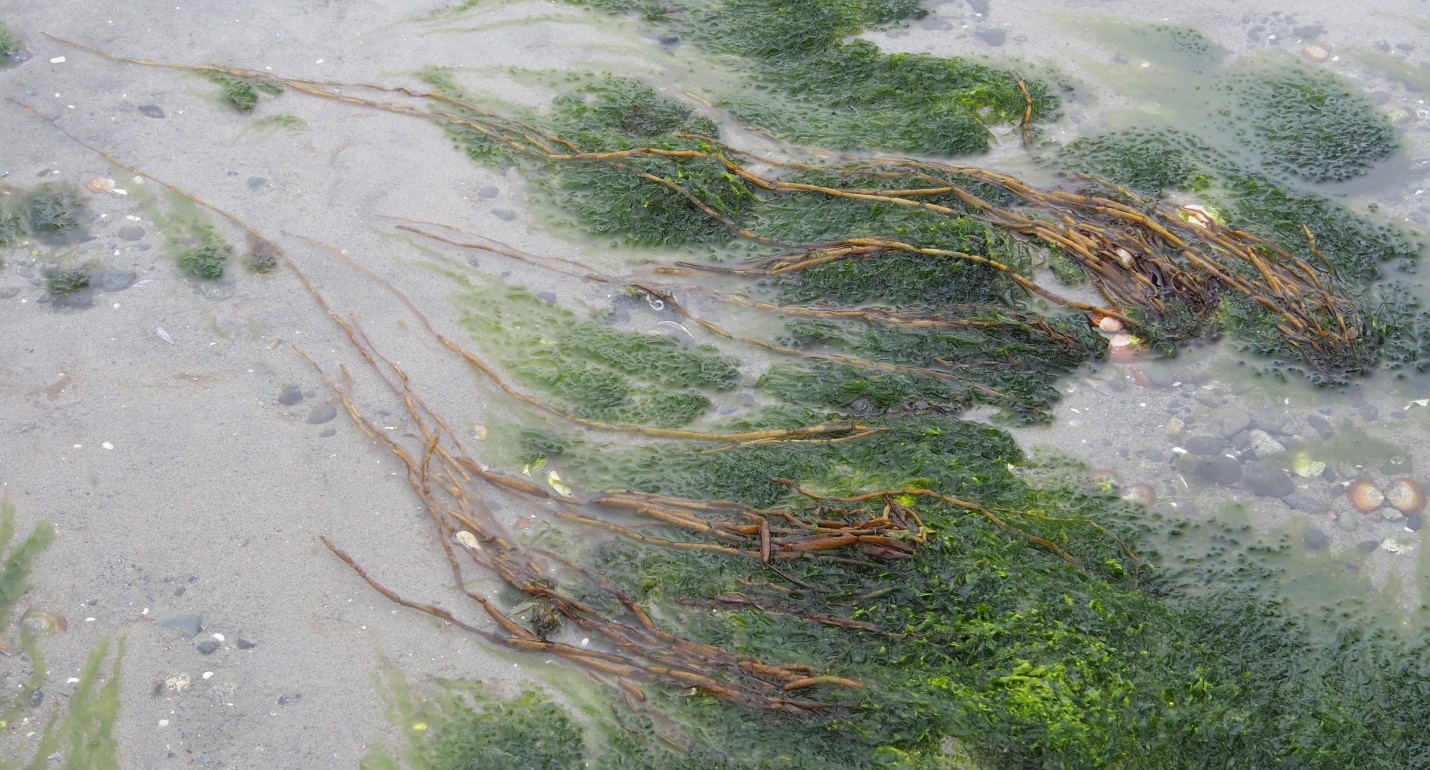
Figure 1: Groups of Beanweed or Soda Straws – Scytosiphon lomentaria, are viewed here at low tide. The long hollow tubes are designed to float and thus all came to rest atop the Ulva and other nearby algae. Little Qualicum River Estuary, Strait of Georgia, B.C., Canada. April 28, 2025. Photo ID 27774 ©Seaweedwhisperings.com
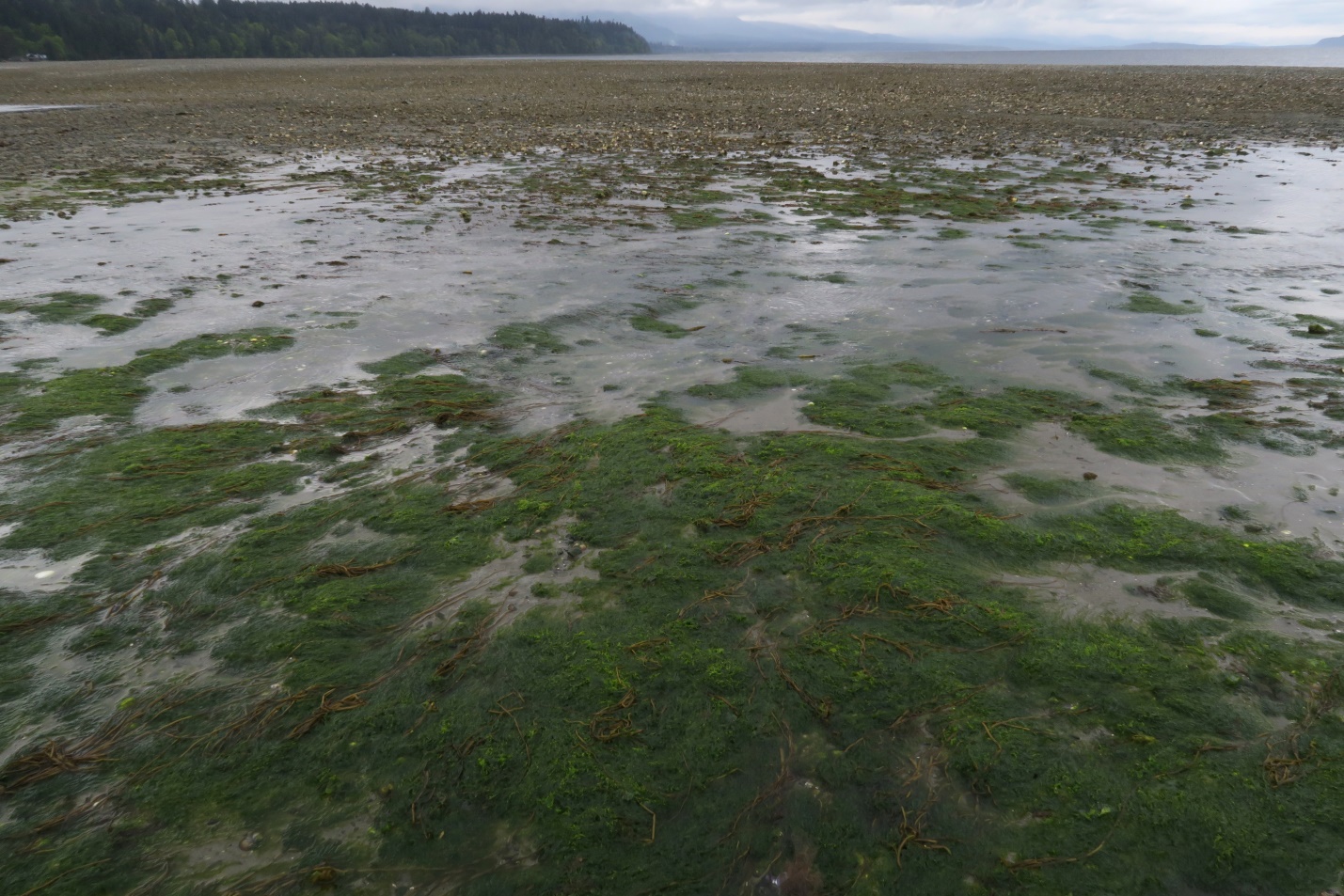
Figure 2: A “weedy” species that is known to colonize disturbed areas easily, in the photograph above much of the area is home to this year’s crop of Beanweed or Soda Straws. Little Qualicum River Estuary, Strait of Georgia, B.C., Canada. April 28, 2025. Photo ID 27775 ©Seaweedwhisperings.com
Person 1:
Knows where it’s going, but doesn’t know how it’s going to get there.
Has the appearance of beans, where all the seeds haven’t developed fully (likely from poor, uneven pollination) so the appearance is like a bean pod with some full sections, then some constrictions where one hadn’t developed, and then back to another full section. This relates to arrested growth, when your group isn’t functioning properly. With your friends or associates there’s something off, so it’s throwing the individual off from thriving, too.
Prefers to go it alone. However, it can politely associate with others but keep a bit of distance.
Long and skinny like a snake, with a bit of irregular waviness in form. Does this allow Scytosiphon to weave its way forward through difficult situations? Maybe it can surreptitiously meet its goals without anyone knowing about it.
This aspect of surreptitiousness involves a level of deception, basically covering up or hiding what’s really so.
As it matures, it rapidly begins to look tired, perhaps suffering burnout from its directional determination.
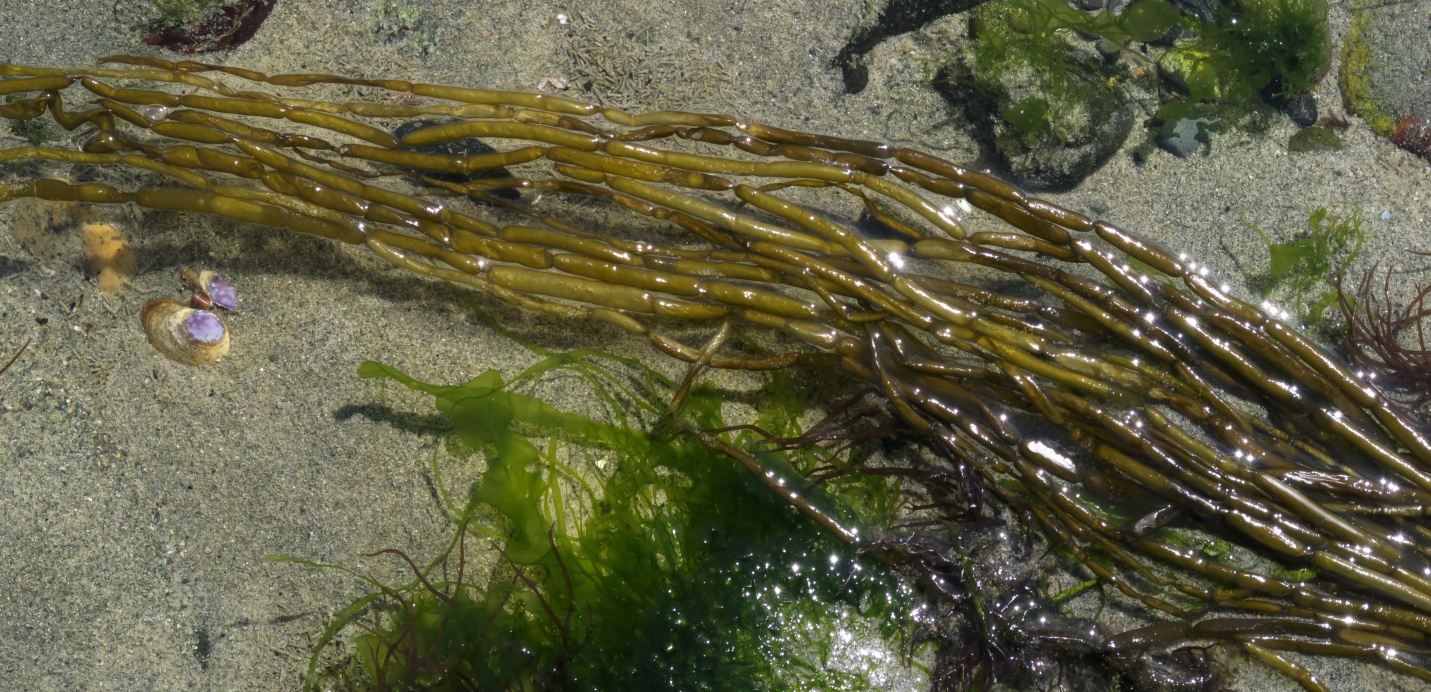
Figure 3: A closer view of the cylindrical tubes of Scytosiphon lomentaria seen here floating in very shallow water. The constrictions are not always present, and they separate the tubes into separate little “floats”. When immersed the thallus lifts upward from its discoidal holdfast very effectively. Little Qualicum River Estuary, Strait of Georgia, B.C., Canada. April 16, 2025. Photo ID 27776 ©Seaweedwhisperings.com
Person 2:
This long slender seaweed grows together in groupings. Very rarely you’ll see only one strand of beanweed, but by far it is more typical to find a group of several long, unbranched tubes, all attached at a common anchor point.
This
seaweed can actually grow to be quite long, and several individuals
today were about 1 meter or a bit more in length; in groupings often
there would be some variation in lengths of the tubes, but overall,
if they all got started growing at a similar time, many of the
longest in all the neighboring groups would reach a similar overall
length. The width of the ‘tubes’ we found today were mainly
around .7 to 1.0 mm.
Perhaps this is a rapidly growing
seaweed; the common name “beanweed” could imply that – i.e.
“growing like a bean”. We also have only encountered it in the
spring season in our area. It seems as if it appears on the scene,
grows like a weed, and then disappears before summer’s full
intensity.
The ‘tubes’ are constricted at irregular intervals, creating a look somewhat like that of a set of links of narrow sausage. However these tubes are not filled with anything, they are hollow.
These strings of “beanweed” or “soda straws” float at the surface in low water situations. Air is retained in the hollow segments creating a natural float. In deeper water and when fully submerged, I imagine that this flotation mechanism would assist the long tubes in reaching upwards from their holdfast, heading towards the light and lifting them away from the substrate.
These long strings of algae can only “go with” the current, and thus they show the direction the water is moving. They have no desire, and indeed certainly not the strength required to resist the current; instead they mark it very plainly.
Its color – a golden brown, stands out in many surroundings, yet a close look at this seaweed shows it often looks a bit disheveled, unkempt, or possibly like it is a bit ‘dirty’ and needful of a good wash. The various grouping of tubes do all generally head with the direction of the water currents but when fully immersed, or when laid out in low water, they are a rather overall untidy looking collection. Some strings wander off a bit, some bend a bit more strongly at a ‘constriction’ than others, some lie atop others, and others seem to go astray from the main group. When I considered this look, the bent oddly or going astray direction, it reminded me of a limb that is not oriented properly, it looks strained and really rather uncomfortable, even painful. I wonder what this ‘discomfort’ is portraying about Scytosiphon.
This seaweed is also considered to be “weedy” in that it can colonize and grow quickly in disturbed areas. Something to its energy relates to this weedy aspect – quick to get on with growth whenever suitable habitat is available, often many individuals move in to the same area at the same time, and then they are all so very busy with growing and doing well together in the new area that they don’t take time for looking tidy, well-groomed or particularly outwardly beautiful.
The stems of Scytosiphon lomentaria don’t look anything close to being identically the same but somehow they also don’t look much different from each other either. It feels like internally they can have a desire to be unique or to stand out individually in some way, but they intuit the cost that would bring, that this would separate themselves from the rest of their group, and that is a very uncomfortable thing to contemplate for them.
Messy, disordered, unkempt groups. This seaweed may take advantage of new territory, but not as a solo pioneer. Wherever we’ve found Scytosiphon lomentaria, it is present in groupings, often many, many groupings in the general area. They like to “do life” with the company of companions of their own kind it would seem.
But there is an odd additional factor to them, too. While the long strands of beanweed do grow in groupings that all arise from a single holdfast site, there doesn’t feel like there is much that connects or that is communicated between the individual strings along their considerable length. Their group connectedness must all go all the way back to their origin..., because otherwise it does feel like it is very active, moment to moment or day by day, in their present and individual reaches and efforts.
Since they “stand out” (visually) once they get going and therefore can attract attention to their actions and ideas, perhaps having their ‘like companions’ alongside them gives them the moral support they would lack as solo individuals. Are they not yet ready to hold true to their true nature, to their own knowledge of themselves, if they are alone, or isolated from others of their own type?
This seaweed for some reason seems a bit more ‘primitive’ or unpolished in its overall design. It reminds me of some earlier evolved land plants, especially one ‘horsetail’ species, Equisetum hymale, which grows in distinct segments. As a young child I liked to pull apart those segments and also try to reassemble them. With this seaweed, Scytosiphon lomentaria, I was interested to see what would happen if I pressed on some of the inflated segments. Would they burst? Would they resist outside pressure? Would they squirt out fluid? So there’s something about the morphology of this seaweed that gives rise to curiosity. You want to find out more..., learn how it works, play with it a bit..., etc. Perhaps that is a strong motivation for them in life, too..., “finding out more” and so being engaged in learning is highly satisfying to them.
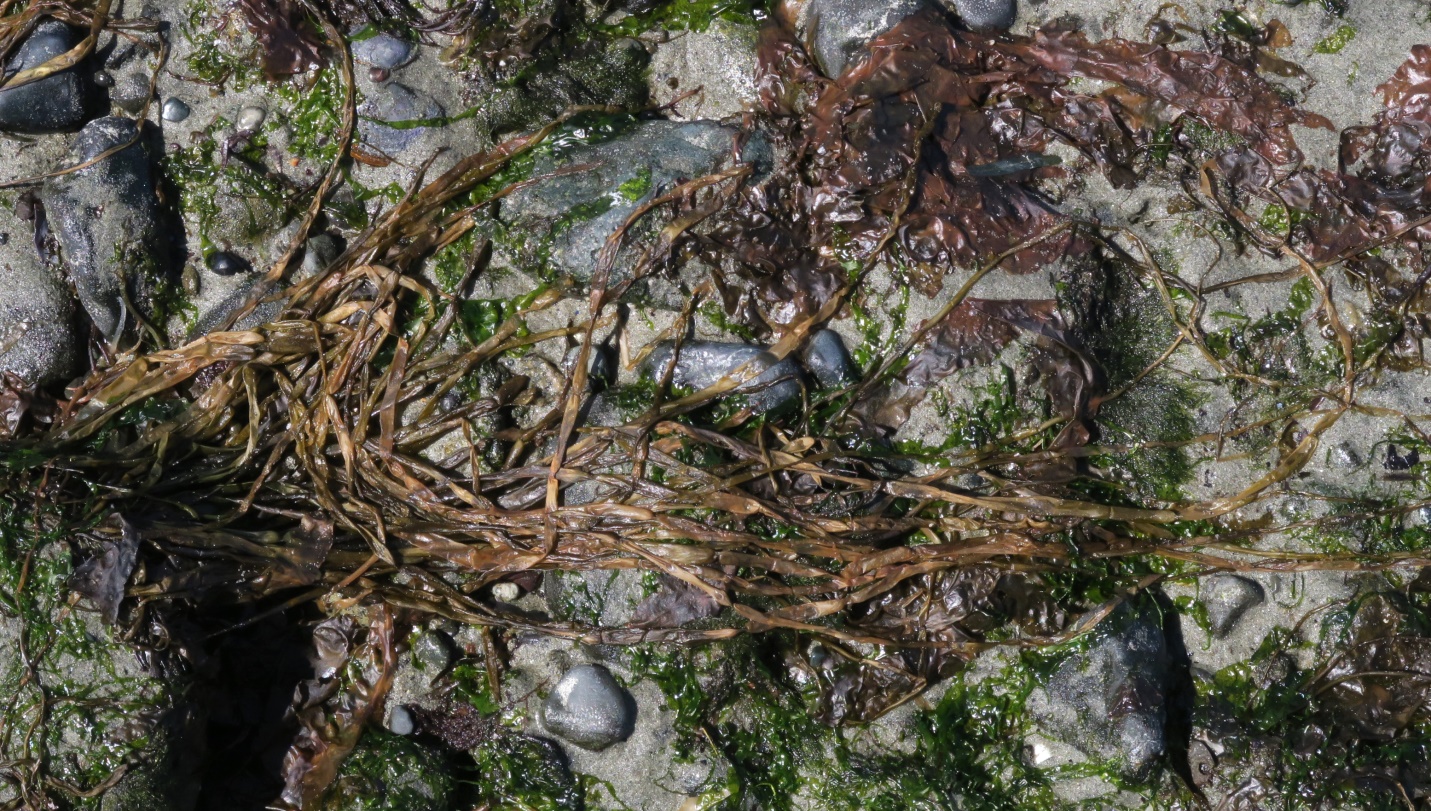
Figure 4: This grouping was growing higher in the intertidal zone and has been subject to more desiccation. Its deflated state makes it look like it is suffering from significant ‘burn-out’. We were unable to return to observe if it would recover with the return of the tide, but somehow that looked doubtful. Little Qualicum River Estuary, Strait of Georgia, B.C., Canada. April 16, 2025. Photo ID 27777 ©Seaweedwhisperings.com
Discussion:
Knows where it’s going but doesn’t know how it’s going to get there. This observation brings up a few concepts. The “how” will hopefully eventually get worked out, and they have the “where” clearly set in their heart/mind. The how might be determined if they work with their group, or..., it will it be better helped if they can’t work with their group and have to “go it” alone?
There’s something to the look of this seaweed that can lead one to think they are somehow ‘incomplete’; it is the hollow or empty tube aspect growing only ever in length that suggests this idea. For them there is something that they are looking for; and somehow they seem to feel that it is from outside of themselves, or further away from where they currently are, that they must look to find it. Their ‘insides’ are an empty space that they are aware of and that they seek to fill appropriately. And it seems that they can try out many things and that very rarely do they find that something coming from the outside actually does satisfy this emptiness. Perhaps for Scytosiphon lomentaria the search needs to come back to a change of perspective – to look within rather than to the very many options outside of and external to them.
Their appearance is that they’re all basically moving in one direction and that they’re looking down the same narrow avenue, when possibly a change of direction, looking elsewhere, might be better. They’re swept up by the current, can be easily swayed by stronger external forces, and they may at first actually truly enjoy this. But they can get stuck in this place and they may not have the actual ability to distinguish this situation or pull away from being highly influenced, pulled along for the ride, absorbed in the convincing dogma that surrounds them. There’s something almost close to a reverence that they can have for these stronger outside influences. They can become perpetual students or earnest followers, keeping up with the teachings of a guru or teacher or other leader.
Occupying themselves by following a strong or influential leader releases them, for a time at least, from finding for themselves what they actually are looking for, from finding what they are seeking to “fill” themselves with. They have the capacity to take in and learn very well, but they sometimes fail to consider running a personal validity or relevance check. Except that..., when they do check in they’ll often find that their hollow interior persists. They can find that much of the knowledge they’ve taken in has been a fascinating distraction, but has not truly begun to satisfactorily fill that hollow empty space within.
Research into the biology tells us that this seaweed has “diffuse” growth, in other words the growth of the alga can occur throughout the entire individual. This differs from other brown alga such as the kelps which are restricted to growth occurring only at the meristematic region (close to the stipe). Possibly this diffuse growth contributes to the uneven or messy look of the stems. There could be a lack of coordination to the growth. Possibly also this means the growth occurring all along the stems truly occupies each stem with ‘work’ all along its measure and that no ‘section’ is finished or complete; each portion is still in the process of getting there, growing towards some completion yet to come.
The fatigued, weary and worn out look observed is possibly coming from the tension between wanting some individual privacy and needing to be part of a group at the same time. Being part of their group is definitely NOT private; that struggle wears them out.
The long skinny wavy somewhat like a snake impression..., which led to the idea of surreptitiously meeting goals and being deceptive and covering up what’s truly so for them – we considered what is going on for Scytosiphon that they would feel this desire to hide things within. We saw a connection also here with the observation that the connectedness along the lengths of this seaweed seems very low; that connections may go back to their origins but are not expressed in their current day efforts and reaches. It feels like the “group life” can be challenging because everyone in the group can be both aware of how the other group mates are doing, and also can fall into the pressures and limitations of wanting to fit in, measure up, and not stray from the group ideals, etcetera. So quite possibly for Scytosiphon the challenge is to both work well with the advantages of group life, and then also work at their ability to ‘stray’ a bit beyond or away from the group, too. To stray means to move away aimlessly from a group or from the right course or place; to wander off, drift, get separated or even lost. So there can be genuine discomfort in a recognized truth to the reality that some of their individual ‘reaches’ must be done “separate from” and hidden from the group, especially if they are new and as yet unapproved. Possibly when they do become aware of their separateness and they let go of the group ideas and thinking, well, Scytosiphon can sense there may be something more or different that might fill their empty insides..., something that they will continue to reach for.
Upon reviewing this write-up we could that there is a bit of a “messy” feel to it. It doesn’t read too terribly but it’s not quite tied together or neatly packaged either! We realized it would be futile to attempt to do that, as the messy and not tied together aspect is prominent in this seaweed.
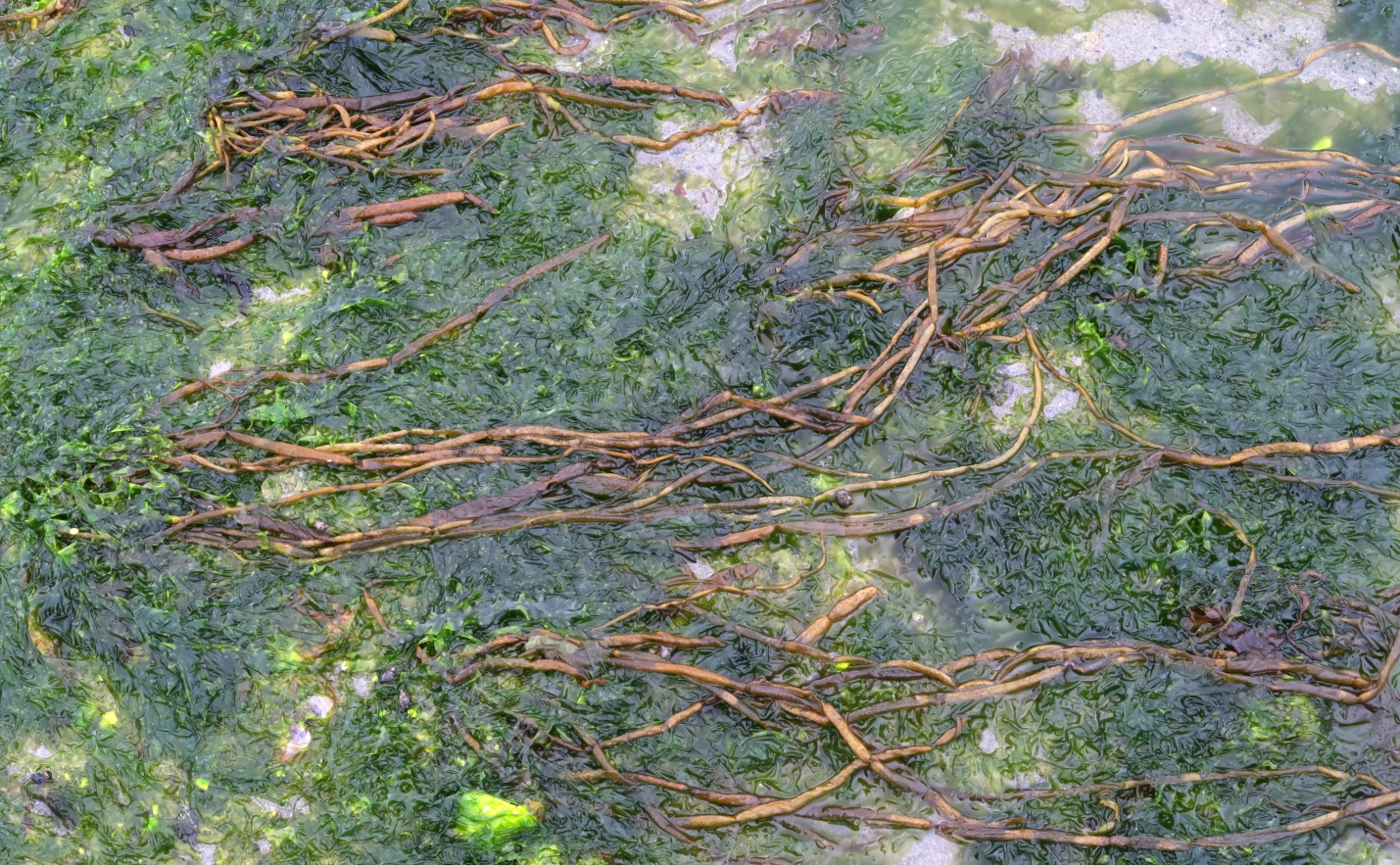
Figure 5: This is ‘rag-tag’ looking group of Scytosiphon lomentaria had grown to maximum lengths known for the species; conditions were obviously favorable here this year. Little Qualicum River Estuary, Strait of Georgia, B.C., Canada. April 28, 2025. Photo ID 27778 ©Seaweedwhisperings.com
Biology & Natural History Information:
Description:
The conspicuous gametophyte phase (which alternates with a crustose sporophyte phase) of this brown alga forms erect, tubular clusters. Typical length is 20 to 50 cm, but longer specimens have been measured at greater than .75 meters. The tubes are hollow, unbranched, up to 1 cm in width, and within each clump at least the larger ones will be constricted along their length at fairly regular intervals – resembling a string of sausage links. Its color is variable – olive brown to dark brown and even a lighter golden brown. The narrow hollow tubes, up to 1 cm wide, arise from a discoidal holdfast. This holdfast can be mistaken for species of the genus Ralfsia.
Habitat:
Commonly found on rock in the mid to low intertidal, and ranges from protected to semi-exposed habitats.
World Distribution:
Beanweed has a wide distribution in the oceans of the world. In the North Pacific it is found in the Bering Sea and Aleutian Islands, Alaska south to Baja California, Mexico. Also China; Korea, Japan and Russia.
Remarks:
This seaweed is described as a “weedy annual”. It can colonize and grow quickly in disturbed areas.
Like False Kelp, Petalonia fascia, which it can grow in association with, Soda Straws lack structural and chemical means to deter herbivores.
This seaweed has diffuse growth (growth that occurs throughout the length of the thallus); this differs from other brown algae, the kelp species, which have growth that is restricted to a special meristematic region.
The species name, lomentaria, relates to “loment” – the pod of some leguminous plants which have constrictions between seeds and that upon maturity break up into one-seeded segments.
Classification:
Empire: Eukaryota
Kingdom: Chromista
Phylum: Heterokontophyta
Subphylum: Ochrophytina
Class: Phaeophycea
Subclass: Fucophysidae
Order: Ectocarpales
Family: Scytosiphonaceae
Tribe: Scytosiphoneae
Genus: Scytosiphon
Species: Scytosiphon lomentaria (Lyngbye) Link, nom. cons. 1833
Former name(s):
Scytosiphon simplicissimus (Clemente) Dremades; Chorda lomentaria (Areschoug) Areschoug.
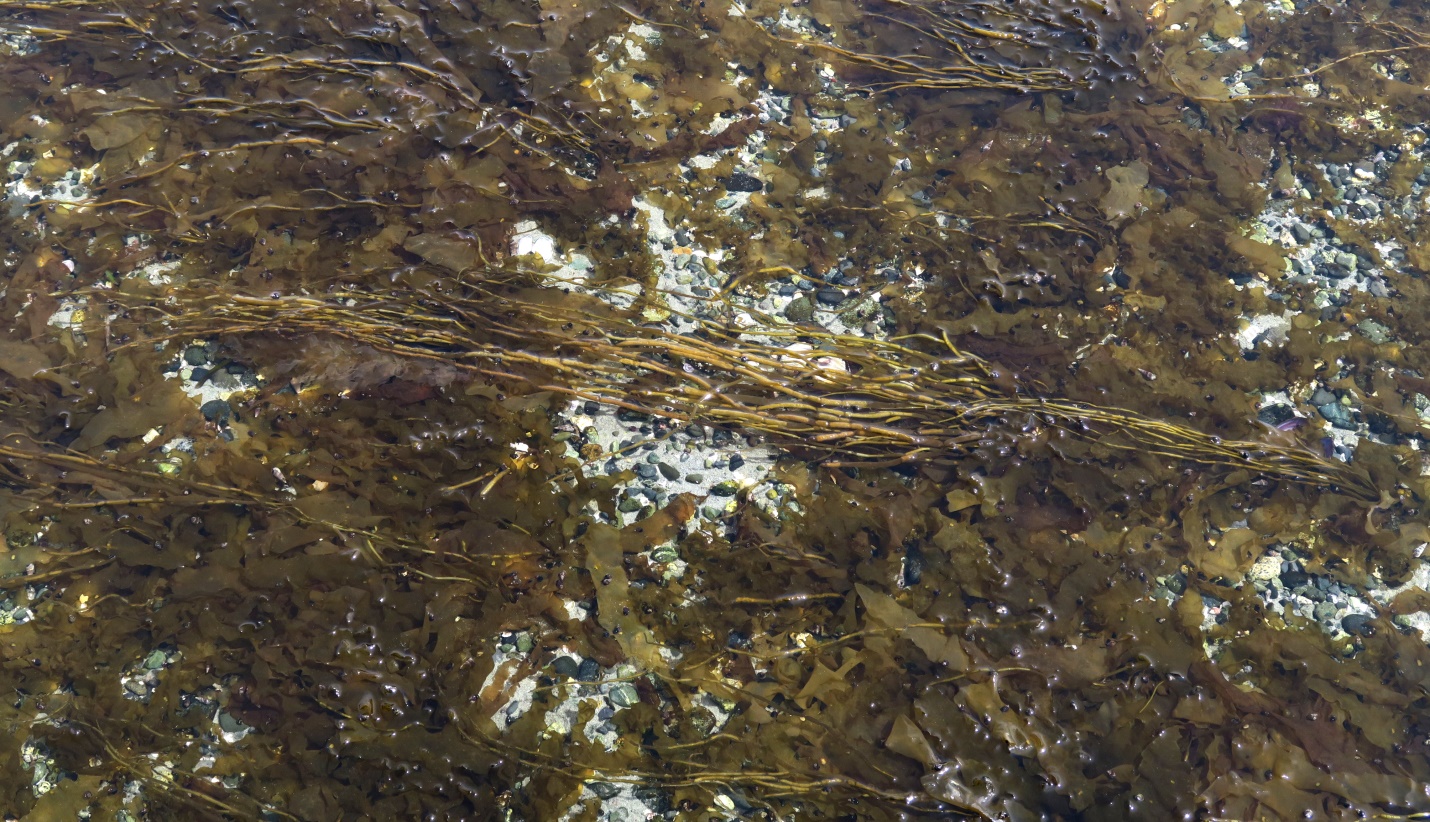
Figure 6: This visit (four years earlier than our Whispering) the clusters of Scytosiphon lomentaria were growing in association with False Kelp, Petalonia fascia. Both species have alternate phases and this is the conspicuous gametophyte phase. Both of these brown algae are noted to have no chemical or structural defence against herbivores, and the Petalonia in particular is being grazed by numerous small marine snails. Little Qualicum River Estuary, Strait of Georgia, B.C., Canada. April 29, 2021. Photo ID 27779 ©Seaweedwhisperings.com
![]()